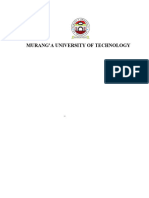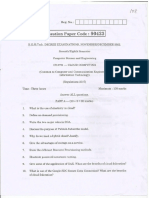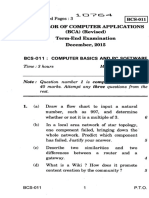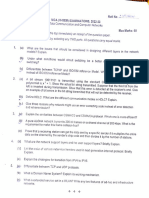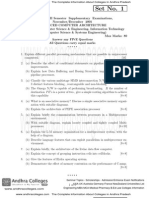0 ratings0% found this document useful (0 votes)
84 viewsDistributed Computing Model Exam Question
Uploaded by
mancymithinCopyright
© © All Rights Reserved
Available Formats
Download as PDF, TXT or read online on Scribd
0 ratings0% found this document useful (0 votes)
84 viewsDistributed Computing Model Exam Question
Uploaded by
mancymithinCopyright
© © All Rights Reserved
Available Formats
Download as PDF, TXT or read online on Scribd
You are on page 1/ 2
Reg No:
B.E. DEGREE MODEL EXAMINATIONS-NOVEMBER 2024
FIFTH SEMESTER
COMPUTER SCIENCE AND ENGINEERING
CS8603-Distributed Computing
(REGULATIONS 2021)
Time :3Hours Date:21/11/2024
Max. Marks: 100 Marks
Answer ALL Questions
PART A-(10x2=20 Marks)
1) State the differences from synchronous and asynchronous communication along with the
buffering strategy adapted in both.
2) List the role of shared memory systems.
3) How do you define the scalar time and the vector time?
4) If the two events e1 and e2 of two different processes occur at same time,
independently. What kind of relationship exists between e1 and e2?
5) What are the various deadlock detection in distributed system? State a common factor in
detecting the deadlock.
6) How beneficial is the Chandy-Misra-Haas algorithm in the AND model and OR model?
7) What is a checkpoint in the recovery system? How it is useful?
8) State the issues in failure recovery. State the means to identify failure at an early stage.
9) What is virtualization? Why is it required in the larger organization?
10) State the relation of compute service with storage service in a cloud environment.
PART B - (5x13=65 Marks)
11) (a) Explain message passing systems and discuss on the message oriented middleware
and its types. Also explain their functionality in distributed computing.
Or
(b)Analyze the concepts of heterogeneity, openness, security, scalability impact of the
distributed systems. How the standardization of them is make them effective?
12) (a) Give a real time scenario where FIFO message queue is used. Write and describe the
snapshot algorithms for FIFO channels.
Or
(b) Describe the physical clock synchronization and logical clock synchronization
and explain the framework of a system of logical clock.
13) (a) State the Lamport’s algorithm and its use and also the limitations and benefits.
Compare this with any two token based algorithms.
Or
(b) Explain the system models with its preliminaries and how is it
characterized in the models of deadlock.
14) (a) Explain the facts associated with agreement in failure-free systems of both synchronous
and asynchronous systems.
Or
(b) What are the different checkpointing based recovery systems available? Explain the
coordinated check pointing algorithms with illustration.
15) (a) A company like to have an advanced collaboration services like video, chat and web
conferences for their employees, but their system does not support any of the IT resources due
to insufficient infrastructure. If they could leverage cloud computing technology in their
system, suggest a suitable cloud type with proper justification. List the characteristic of cloud
computing.
Or
(b) Explain the different cloud services and the platform that support these services. Give an
example for application service adapted by any organization.
PART C - (1x15=15 Marks)
16) (a) Consider an ABC IT company wanted to provide services like scientific converter, data
converter, currently converted and some of the business logic as a server side component to
the developer to tailor makes the applications. Explain the various adaptable technologies to
implements in a distributed. State its merit and demerits.
Or
(b) An organization has planned to implement a client module that emulates a conventional
file system interface for application programs,and server modules, that perform operations for
clients on directories and on files. State the best distributed architecture to delay and deliver
the system. Also explain the suitable system model to avoid failures and adapt a recovery
system for the same in case of unavoidable failures.
You might also like
- ECDSA SCRIPT TO SCAN FOR REUSED R VALUES - PyNo ratings yetECDSA SCRIPT TO SCAN FOR REUSED R VALUES - Py17 pages
- Cse Am 2021 Cs 8603 Distributed Systems 755643105 x10324 (Cs8603) Distributed SystemsNo ratings yetCse Am 2021 Cs 8603 Distributed Systems 755643105 x10324 (Cs8603) Distributed Systems2 pages
- mtech-cse-2-sem-distributed-computer-systems-2010No ratings yetmtech-cse-2-sem-distributed-computer-systems-20104 pages
- M. Tech. Semester - I: Distributed Computing (MCSCS 101/1MCS1)No ratings yetM. Tech. Semester - I: Distributed Computing (MCSCS 101/1MCS1)20 pages
- M. Tech. Semester - I: Advanced Computer Architecture (MCSCS102IBMCSCS 902)No ratings yetM. Tech. Semester - I: Advanced Computer Architecture (MCSCS102IBMCSCS 902)12 pages
- Distributed Information Systems Exam June 2006 - UK University BSC Final YearNo ratings yetDistributed Information Systems Exam June 2006 - UK University BSC Final Year7 pages
- Btech Cs 4 Sem Operating System Ncs 401 2017No ratings yetBtech Cs 4 Sem Operating System Ncs 401 20171 page
- sathyabama-IIsem-Distributed Computing-683201-783201No ratings yetsathyabama-IIsem-Distributed Computing-683201-7832012 pages
- ICS 2202 - Operating systems - December 2023No ratings yetICS 2202 - Operating systems - December 20233 pages
- 09-Algorithms For Vlsi Design AutomationNo ratings yet09-Algorithms For Vlsi Design Automation1 page
- Time: 3 Hours Maximum Marks: 100 (Weightage: 75%) Question Number Is and Carries 40 Marks. Attempt Any Questions From The RestNo ratings yetTime: 3 Hours Maximum Marks: 100 (Weightage: 75%) Question Number Is and Carries 40 Marks. Attempt Any Questions From The Rest3 pages
- The Bcs Professional Examination Professional Graduate DiplomaNo ratings yetThe Bcs Professional Examination Professional Graduate Diploma2 pages
- EE6006 - ASC Anna University Question Nov Dec 2016No ratings yetEE6006 - ASC Anna University Question Nov Dec 20168 pages
- Information and Communication Technology Ict5 Unit 5 Information: Policy, Strategy and SystemsNo ratings yetInformation and Communication Technology Ict5 Unit 5 Information: Policy, Strategy and Systems3 pages
- Fourth Semester B.Tech Degree Examination July 2021 (2019 Scheme)No ratings yetFourth Semester B.Tech Degree Examination July 2021 (2019 Scheme)3 pages
- M.tech (2nd Sem) Previous Paper For C.S.E.,May 2011, PTUNo ratings yetM.tech (2nd Sem) Previous Paper For C.S.E.,May 2011, PTU10 pages
- Answer ALL Questions. PART A - (10 2 20 Marks)0% (1)Answer ALL Questions. PART A - (10 2 20 Marks)2 pages
- I MCSE-011 I MCA (Revised) Term-End Examination 1:3 June, 2018No ratings yetI MCSE-011 I MCA (Revised) Term-End Examination 1:3 June, 20182 pages
- Microsoft AZ-400: Designing and Implementing Microsoft DevOps Solutions - Certification Exam PrepFrom EverandMicrosoft AZ-400: Designing and Implementing Microsoft DevOps Solutions - Certification Exam PrepNo ratings yet
- Models and Analysis for Distributed SystemsFrom EverandModels and Analysis for Distributed SystemsSerge HaddadNo ratings yet
- Slides For Chapter 1 Characterization of Distributed SystemsNo ratings yetSlides For Chapter 1 Characterization of Distributed Systems9 pages
- Bit Torrent: - Scalability Issues For Client/server SystemsNo ratings yetBit Torrent: - Scalability Issues For Client/server Systems12 pages
- CS8492 /database Management Systems 2017 RegulationsNo ratings yetCS8492 /database Management Systems 2017 Regulations20 pages
- Bundelkhand University, Jhansi: "Data Mining"No ratings yetBundelkhand University, Jhansi: "Data Mining"6 pages
- Title: Presented By:-Gaurav Sharma Roll No. - 19EMCCS037 Batch - A, Year - 4th Branch - CSENo ratings yetTitle: Presented By:-Gaurav Sharma Roll No. - 19EMCCS037 Batch - A, Year - 4th Branch - CSE13 pages
- Fast Serializable Multi-Version Concurrency Control For Main-Memory Database SystemsNo ratings yetFast Serializable Multi-Version Concurrency Control For Main-Memory Database Systems13 pages
- Preface Vii: Transactions Recoverability Serializability Database System ModelNo ratings yetPreface Vii: Transactions Recoverability Serializability Database System Model3 pages

















